Have you ever wondered about what music supervisors do?
Check out my latest article featured on Emmy Magazine!




Have you ever wondered about what music supervisors do?
Check out my latest article featured on Emmy Magazine!




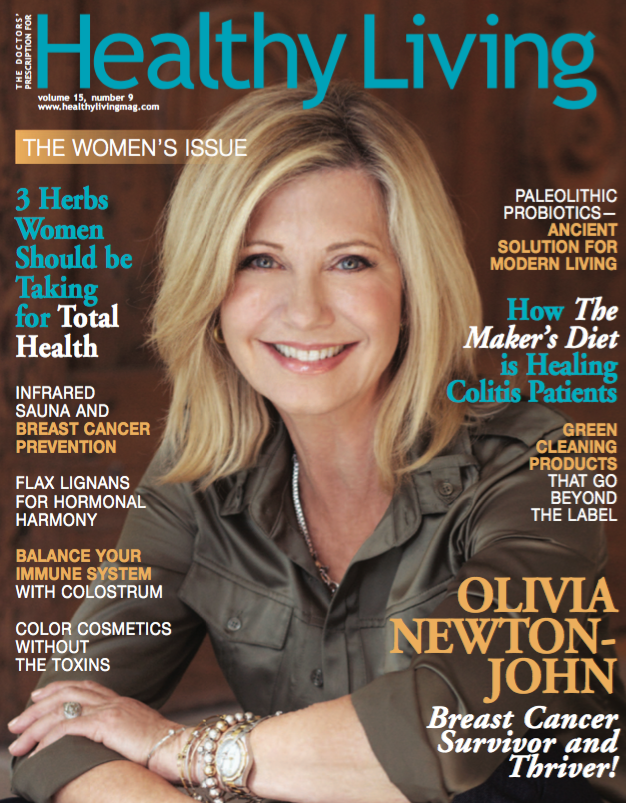
It has been a long time since I’ve posted a blog here, but today called for it. The news hit a few hours ago: Olivia Newton-John has passed away. My heart goes out to her husband, daughter, family, and friends.
I remember first hearing her voice on the radio when I was a young girl. It was distinct and beautiful, like Joni’s Mitchell’s, but all its own. Then in Jr. High School, Grease was released. I saw it multiple times with my teen friends. We learned the songs and practiced the dances. And oh how we wanted to be Olivia!
I remember one early summer evening in Los Angeles, we jumped on top of car parked in a driveway facing Sunset Boulevard near Barrington Avenue and reenacted “Greased Lightning” for the rush-hour traffic, receiving many approving and supportive honks from drivers as they passed by. In the 80s, Olivia remained in the charts with hits like “Let’s Get Physical” and many others. From time to time, friends would see her around town – especially in Malibu at Something’s Fishy Here. (Those who remember know!) And in the 90s, we shopped in her retail store called Koala Blue.
In my adult life, I came to know her in a different, more personal way. She was a well-known breast cancer survivor. My work as editor of Healthy Living Magazine connected me with her for an article on Breast Cancer Awareness (cover image above, article below). One day I found myself talking to my childhood superstar about how her mother cooked wholesome food for her as a child and the impact it had. I spoke to her husband as well, Amazon John Easterling. They were very committed to wellness. Coincidentally, during the interviews, I learned about their advocacy work for tropical rainforests. I was just finishing up a book on the same subject. Several months later I reached out to them again to ask if they would write the foreword to my book, and they graciously agreed. I was thrilled!
Having their endorsement with the foreword elevated the book’s profile, and helped to ensure a national order for all the Barnes and Noble stores. The book got featured on the chain’s Earth Day display tables across the country and even picked up some awards. I’ll be forever grateful to them both. I know they agreed because they genuinely cared about the rainforests, and they believed in the book’s message about individuals making informed consumer choices that could make a difference for tropical ecosystems.
So, in honor of Olivia Newton-John and her husband, John Easterling, I am posting their foreword below. I hope it inspires you to support the rainforests of the world or even make a donation in her name. The organization they supported is called the Amazon Center for Environmental Education and Research. They have served on its board for many years. You can link to it here: https://aceer.org/donate/
FOREWORD from
50 Simple Steps to Save the World’s Rainforests by Kim Henderson (Freedom Press, 2012)
For centuries, explorers and treasure hunters have been drawn to the world’s rainforests in search of wealth and fame. The allure of the rainforest’s secrets has pulled thousands into the jungle to try to break the code of its many marvels and unravel its mysteries. Lost cities of gold, advanced civilizations that have disappeared, diamonds and mineral mining have been historic drivers of this interest. More recently, the demand for lumber, cattle ranching, oil exploration and soybean farming have placed unprecedented pressures on an already diminishing rainforest. These threats beg the query, can our rainforests survive another generation? Will tropical ecosystems pass a tipping point and not be able to regenerate? The real question is, what is the truest value of the rainforest to our species, and how do we realize this value in a sustainable way?
The Amazon rainforest, in particular, is our planet’s greatest natural resource. We may have lost half of our planet’s rainforests in the last 100 years. Another alarming statistic is that of an estimated 4 million indigenous Amazon rainforest people living in 1900, only 200,000 remain. Only 2 percent of the Earth’s surface remains rainforest, yet 50 percent of all plant and animal species are represented there. It is home to
more plant and animal species than any other ecosystem on Earth. It produces almost a third of our oxygen and is the largest climate stabilizer. Healthy rainforests absorb carbon emissions from the atmosphere. Cutting down and burning rainforests release the stored carbon back into the atmosphere, contributing to global warming.
There are so many medicinal and therapeutic plants in the Amazon that it is called the “natural pharmacy to the world.” The research of Dr. James Duke has linked thousands of beneficial compounds naturally occurring in rainforest plants to potential benefits for the most common diseases in the developed world. Seventy percent of all plants that have anti-cancer activity come from the rainforest, yet only a tiny 3 percent have been scientifically studied for their therapeutic benefits. Not only is the rainforest full of unique chemical and nutritional compounds, there is an innate plant intelligence that resonates through the composite of the rainforest.
We are grateful for these rainforest plants as they have substantially improved our health in times of crisis, and we use them daily as part of our health regimen. In the last 20 years that we have been going to the rainforest, we have seen dramatic changes both good and bad. We are optimistic about the future because more and more conscious people are realizing that tropical rainforests are more valuable alive than dead.
It is not just a novel idea to have a responsible attitude about the preservation of our rainforest. The fact is the very survival of our species is dependent on a
healthy rainforest, and we are all decision makers in our future. Every day we vote with our money and our actions. It is simple environmental economics. For most of us, it is easy to see the global value of the rainforest. However, when we acknowledge the personal value we get from the rainforest, like oxygen, we realize we each have a personal relationship with the rainforest. It’s when we make that connection that we begin to make the personal everyday choices that ensure we have access to that value. We appreciate the extraordinary inventory of new therapeutic and medicinal plants that may hold the key to reversing all degenerative disease as we know it. In the PBS documentary Return to the Amazon, Jean-Michel Cousteau’s words, “We protect what we value,” continue to ring true.
Recognize the value of our living rainforest. We are the guardians. Ultimately our individual choices taken as a collective will determine its future. The real beauty of Kim Henderson’s book is that it is so simple. Following the practical tips and guidelines on these pages can help turn the tide toward a bright future for our rainforests and ourselves.
Be conscious, be healthy, and thanks for being a part of the solution.
— “Amazon John” Easterling, Treasure Hunter and Founder of the Amazon Herb Company
— Olivia Newton-John Easterling, First United Nations Goodwill Ambassador for the Environment
Thank you, Olivia, for the impact you made on my life and countless other’s with your music, movies, and breast cancer awareness and rainforest conservation advocacy.
May your bright spirit continue to inspire from beyond the veil.
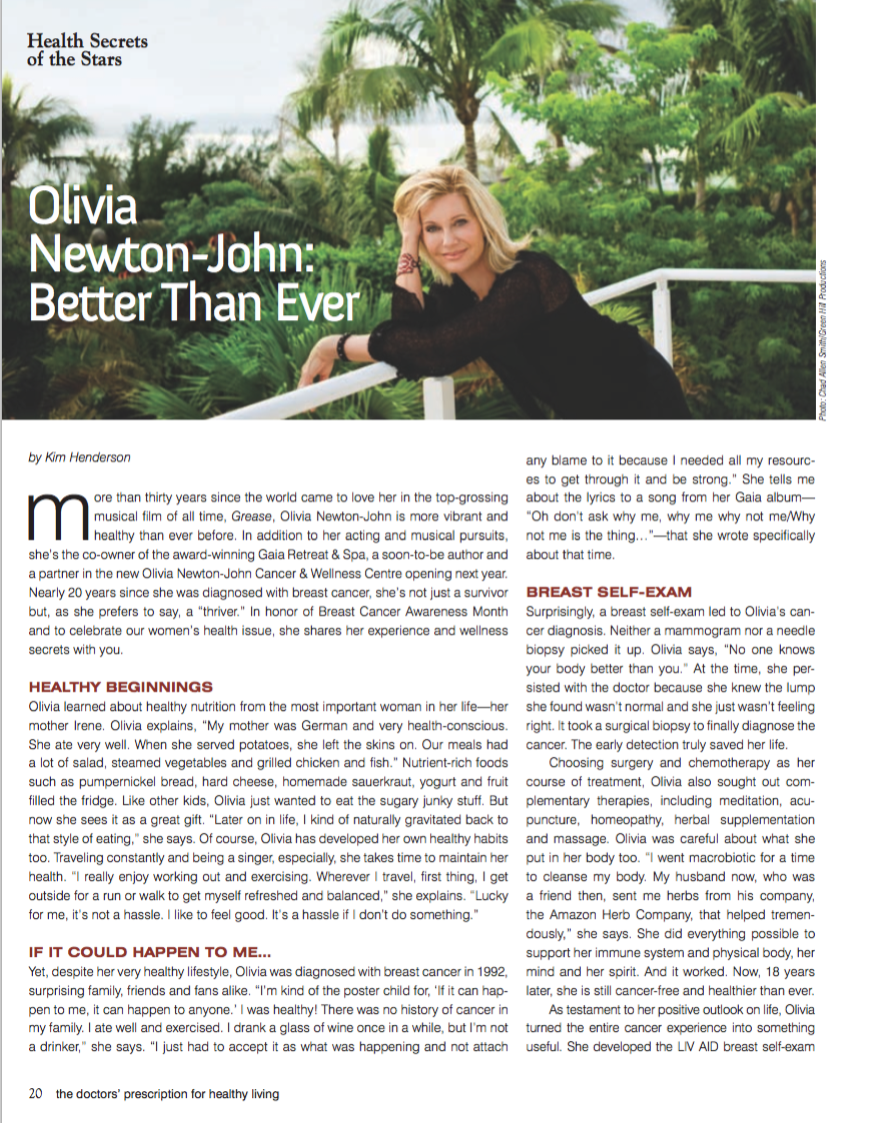
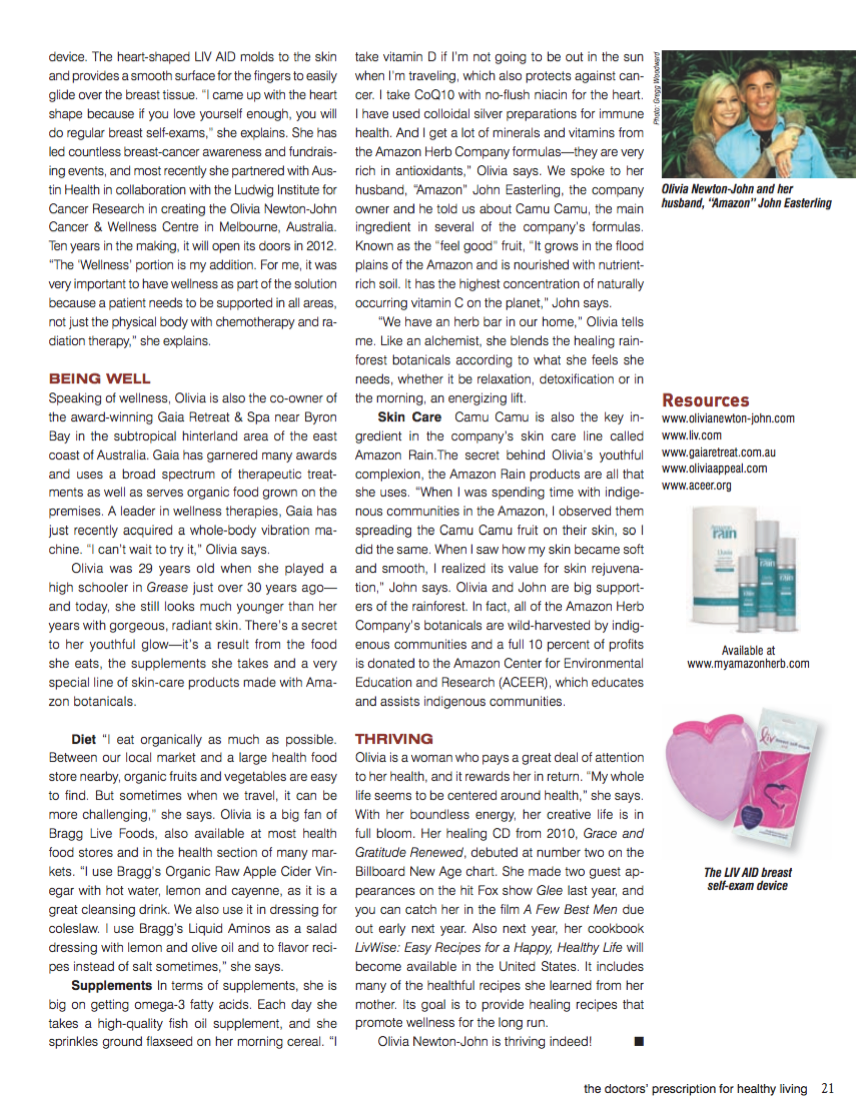
Here’s my latest cover/cover interview that I coordinated and conducted for Good Health Lifestyles magazine featuring Kris Carr. A longtime cancer thriver, Kris embraces a whole foods, vegan diet. A bestselling author, her latest book Crazy Sexy Juice makes juicing more appealing than ever…just in time for spring. Enjoy! 


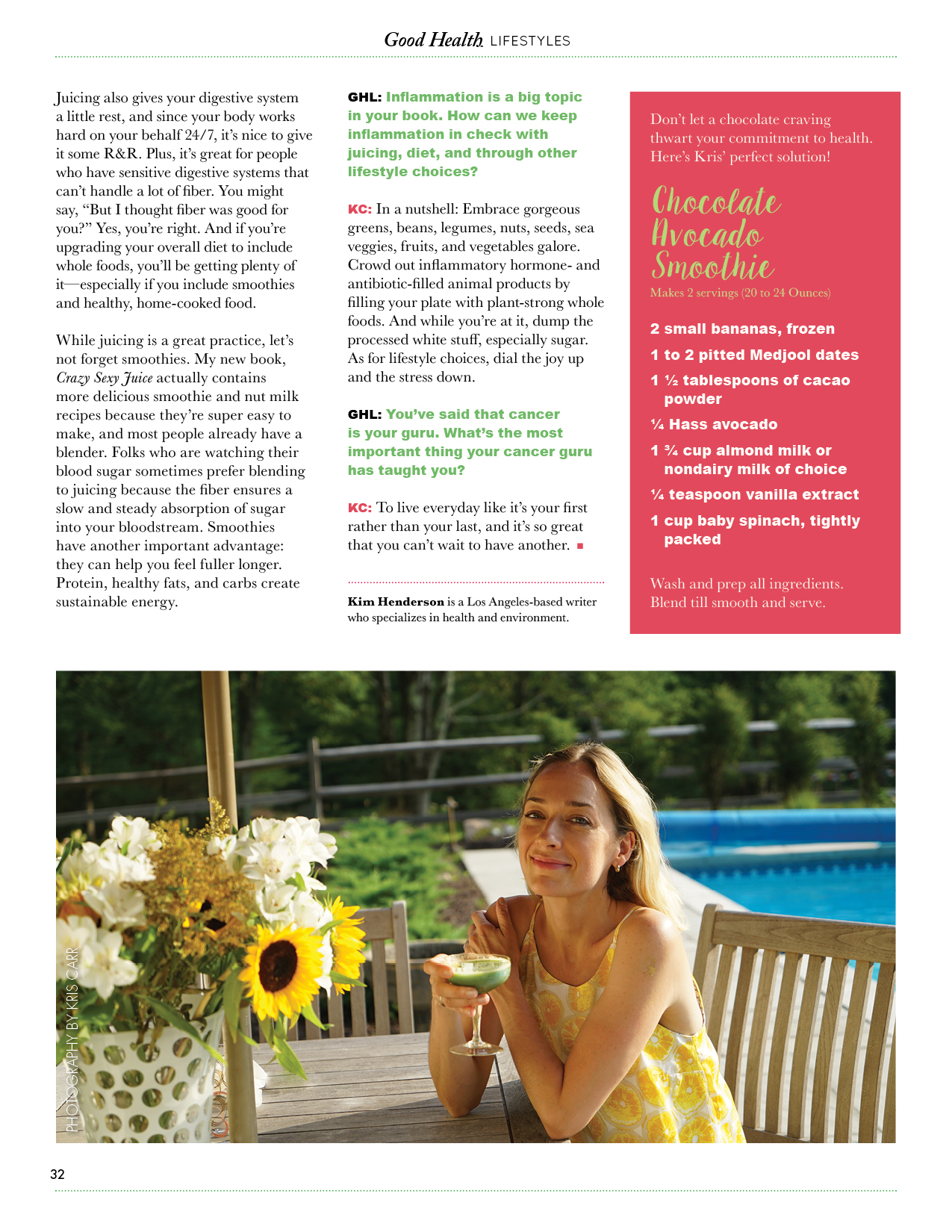
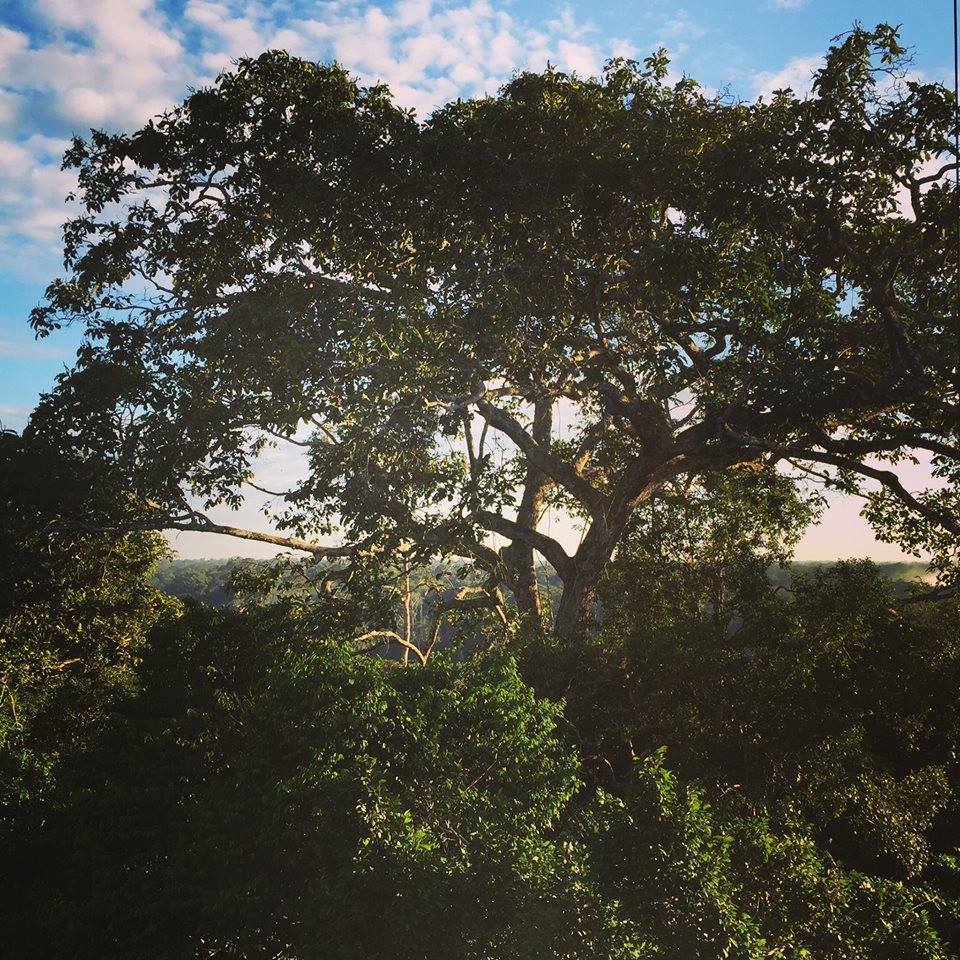
We all have a special relationship with nature. If you pay attention, you might discover that a particular plant, place or animal in nature will be closely linked with our experiences. In fact, I believe they find their way into our psyche and spirit and teach us things, if we are open.
Think about this for a moment. Let your mind drift back to your first memories. Is there a flower, animal or tree that is knit into the fabric of your childhood memories? Oftentimes the smell of a certain tree, or the droppings of its fruit, a particular wild flower, a bird or animal will come to mind.
The ones from my Southern California childhood come easily—oak, sycamore (and even poison oak!), lemon and orange trees and flowering fuschia. I had day-to-day contact with these trees and flowers growing up. I find comfort whenever I am around them. Seeing them and smelling their fragrance frequently remind me of who I really am, when I get lost. A grand oak stood just outside our home’s back door. I spent hours riding a tricycle around it. That tree housed a family of raccoons that came down to our patio nightly to drink the water and eat the bread we left for them. That oak felt like the grandfather I never met. I felt protected around it. And I delighted in the acorns that fell, like jewels from heaven, to the ground each fall.
When I set off to lead a writing workshop in the Peruvian Amazon, I got really excited thinking about the iconic exotic animals most everyone associates with the jungle—you know the ones—monkeys, macaws, giant, oversized snakes and the crowning glory of them all, the jaguar. Yet, more than all of the animals, I was most excited to see a special tree—one that I had come to know through my work in words and images only—the Brazil nut tree.
I first learned about the Brazil nut tree in 2009, when I was researching simple actions people could take to save the rainforest for a book I was writing. At the time, I did not know how deeply I would come to love and appreciate this mighty tree. Love is like that. Even love of non-human things. It finds its way into your heart and catches you by surprise.
I discovered that the Brazil nut tree grows only in the Amazon rainforest, the largest rainforest on our planet, spanning Brazil, Peru, Bolivia, Venezuela, Colombia, Guyana and French Guyana. Surprisingly, I learned that Bolivia is actually the largest exporter of Brazil nuts, not the country that bears the nut’s name. And perhaps most unique of all, Brazil nut trees have one distinction that makes them particularly beneficial to rainforest conservation: They only grow in forested areas.
Brazil nut tree plantations have largely failed. The failure has been attributed mostly to the fact that the Brazil nut flowers are pollinated by a certain orchid bee that lives in the rainforest, and this orchid bee is difficult to control in a farm-like setting.
The bottom line is that Brazil nut trees need to grow in forested areas if they are to be pollinated by the bounty of orchid bees that live there. As a result, huge swaths of the Amazon rainforest are preserved for the Brazil nut trade. That means that consumers in western countries, like the U.S., can help ensure a healthy Brazil nut trade by purchasing and enjoying Brazil nuts. This, in turn, brings sustainable income to local communities throughout the Amazon, where Brazil nuts are collected. Local communities are then motivated to preserve the rainforest because intact forested areas bring income.
I love the Brazil nut story.
I love even more that Brazil nut harvesters are called the “Guardians of the Rainforest” because they truly are. The harvesters hand collect the large nuts using machetes to break their pods, hiking the rainforest floor with sometimes 175 pounds of Brazil nuts on their backs! I think about all of that when I eat a Brazil nut now.
There’s a bit more to the story, too. And it involves a giant rat.
There’s a large rainforest rodent called an agouti. (It’s actually very cute.) The agouti is about the only animal with strong enough jaws and sharp enough teeth to break the pods and hard shells surrounding the Brazil nuts. They do this and store some of the nuts, like a squirrel. However, they inevitably forget about some stored nuts. And when a tree falls and opens up a space of sunshine in the forest canopy, the stored nuts germinate into new Brazil nut trees. It’s a beautiful cycle of death and rebirth.
The entire Brazil nut story is a triumphant one for a nature lover like me. It’s as if the Brazil nut tree stood up (literally) for the rainforest.
It’s exciting when nature triumphs over greed.
I became so enamored with Brazil nuts, agoutis and rainforest saving, I told the story frequently when I was on the road promoting my book. I told it at schools and to friends. I served Brazil nuts at my book signings and began eating them as snacks. I chopped, roasted and sprinkled them on vegetable dishes, pasta and hot cereal—and added them to chocolate chip cookies. I even roasted them at holiday time with savory spices and gave them as gifts with the Brazil nut story enclosed in order to spread the great news of their rainforest-saving benefits. People responded and asked for more!
So, the Brazil nut tree was very high on my list when I made my first jaunt to the Peruvian Amazon last July.
It was the late afternoon when our boat turned off the quiet and serene, clay-colored Tambopata River to the dock of Posadas Amazonas, the eco-lodge that would be our home base for the duration of our stay. Our entire group—a collection of climate change specialists mixed with several of us writer-adventurers—was truly excited. You could feel it. We silently followed each other in one solitary line first up the wooden stairs, and then step by stone step about a quarter mile through the thick forest to the beautiful wooden, yet simple, clean and comfortable entrance of Posadas Amazonas. We were greeted with smiles by our Peruvian hosts and given glasses of a mysterious, sweetly refreshing native fruit juice drink that we all drank without question.
In what seemed like just moments, we shed our belongings in our rooms and headed out to the nearby watchtower, where we could get a sunset view of the majestic Amazon. Single file again, we made our way for our first walk in the forest. A trail of leaf cutter ants greeted us first and continued to zig zag across our path throughout our trek. I noticed how our guide asked us to tread carefully as not to step on them. A native to the area, he held a healthy respect for forest life great and small. His deep knowledge and understanding of the plant and animal life commanded respect.
About half way to the tower, to my surprise, there it was! And so soon! I came to the base of my long-distance friend, the Brazil nut tree, rising up all the way to the very top of the canopy. Months of preparation, three planes, a night in a jungle frontier town, a nauseating bumpy bus ride and a boat ride had brought me to this moment. I had finally “arrived” in the Amazon, the land of Brazil nut trees.
I gazed at the base of this tall, awesome (in the truest sense of the word) tree and looked up to the canopy and down again. I could feel its strength. Although Brazil nut season had long passed, the Amazon saved at least one pod for me to see. At the base of the tree, I saw the decomposing remnants of a Brazil nut pod. Normally full and round like a baseball and about 4 to 5 pounds in weight, however, this pod’s outer shell was partly crushed. The contents were long gone, and its remains were decaying on the rainforest floor. It didn’t matter to me. Just seeing it filled me with joy and excitement. Brazil nut season may have passed, but evidence of its existence lay before me—pods really do grow on the Brazil nut tree and they really do fall to the ground.
Moments later, we arrived at the watch tower and up we went step by step, careful in our pacing as it was a larger group. Higher and higher we climbed. Finally at the top, the last bit of sunlight hit our faces as we looked out at the Amazon and the Tambopata River in all its glory. For as far as the eye could see was a blanket of forest treetops, punctuated only on one side with the winding curves of the Tambopata. There were no buildings, no lights, no roads, and no dwellings—just deep, green forest illuminated by the light of the setting sun.
The next morning, my colleague and I returned. This time, it was just the two of us and our guide. It was not long after sunrise. When we finally reached the top of the tower, the sun had risen quickly and now basked the steaming Amazon in its golden rays. The view was breathtaking. In the darkness the previous evening, I had missed the most glorious sight of all—a sight that now stood before me with tremendous beauty and power. I was gazing at the very top of the most gorgeous Brazil nut tree.
It was spectacular!
Hosting a variety of tropical birds, the Brazil nut tree stood confidently before me, center stage in the forest canopy. It looked like the very tree of life itself!
I stood and observed the Brazil nut tree for what seemed to be a very long time, absorbing the tree’s quiet strength and mature beauty. It had a feminine presence to me, and I felt like I was before a wise, beautiful, caring elderly woman whose presence brought security and comfort. I reflected that soon I would have a significant birthday that marked a departure from my youthful self and the entrance to a more mature identity—a time where, as a woman, you become more powerful. This extraordinary tree had that kind of power. She was a fierce protector of the rainforest by providing her seeds that ensured the survival of her species—and inadvertently helping to protect the forest community she was deeply knit in. Her branches provided a home to many rainforest animals great and small, and her fruit, nourishment and income to her human friends. And in my own way, through my work, I was a protector of sorts of her and her brethren spanning the Amazon. It felt like I was meeting a respected friend I had long admired. Her kindness and beauty and authenticity moved me deeply. Her presence felt all at once like the father I had lost, a universal mother and a connection to something greater all wrapped up into one glorious tree. My beloved Brazil nut tree did not disappoint!
So, I did what most any tourist would do. I took some photos on my iPhone.
A few moments passed and four brightly colored scarlet macaws flew before me in perfect unison. Wow! I was surprised by how completely and totally delighted my spirit was to see these iconic birds fly free—not in a zoo or even captured in a picture, but totally free, flying in their native habitat as it should be.
In that moment, I felt free too. I felt the freedom and wildness of the Amazon with no sign of development, electricity, roadway or building in sight. I felt the freedom of the birds. And I felt the freedom and resolve of the Brazil nut tree. It felt a lot less complicated than life at home. Freedom and simplicity often go hand and hand.
All my efforts to travel to the Amazon were worth that one moment.
Later that day, after lunch at the lodge, I heard a commotion of people looking out at a patch of grass and pointing. I quickly hopped up to see what it was they were observing. (Monkeys made their way through the property frequently throughout the day.) But there before me was a beautiful agouti with the cutest beady eyes you ever did see. It was a sizable creature for a rodent, and very different looking than its North American cousin. A bay brown—similar to the color of a horse, it was simply chewing and sitting in the grass, looking at us looking at him or her. I marveled at this little creature (and unfortunately did not have my camera!) for a short while. Here was the little creature that had a tight-knit relationship with my newfound friend the Brazil nut tree. Oh how I would have loved to see him bite his way into a Brazil nut pod.
But off he scampered under the floor planks of the lodge.
Like that, the agouti, the Brazil nut tree and I were intimate friends–a dream realized, a trip taken.
Five Fun Facts About Brazil Nuts
!. Brazil nuts have enough amino acids to make a complete protein, making them a great protein source for vegans.
2. Brazil nuts are one of the richest natural sources of selenium/ (One nut has 780% of U.S. RDA!) Selenium is a powerful antioxidant that appears to have prostate and breast cancer protective properties.
3. Brazil nuts are also rich in copper, magnesium, fiber, vitamin E and essential fatty acids making them a powerhouse of nutrition.
4. Brazil nut oil is used in skin and hair products for its restorative properties.
5. Brazil nut trees are among the largest in the Amazon growing up to 160 ft. tall,
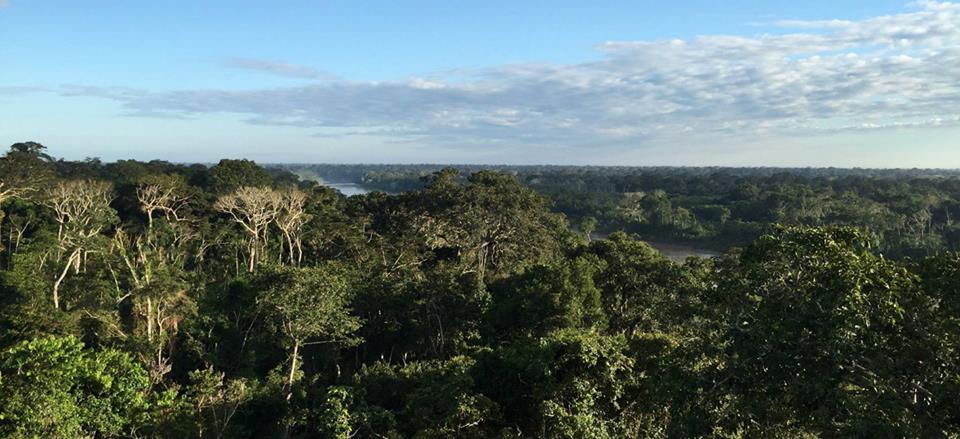
I wish everyone would read The People’s Republic of Chemicals. And I’ll tell you why. China’s pollution crisis is highly underreported. Most people, myself included, have only a vague idea about the toxic soup of chemicals in China’s air, land and water—and even worse, how severely the toxicity is impacting its people.
Authors of the award-winning environmental book, Smogtown: The Long-burning History of Pollution in Los Angeles, William J. Kelly and Chip Jacobs, do a great service in tackling this even greater environmental crisis—one with global implications. According to Kelly and Jacobs, China’s runaway pollution is the cause of a staggering 1.2 million premature deaths to its people per year in the forms of cardiovascular disease, respiratory ailments and cancers of the liver, bone, lung, breast, and blood. They also report on how China’s toxic air pollution extends well beyond its borders to neighboring countries and even across the Pacific to the western United States. Bottom line: The subject is pertinent to us all.
Written with literary flair and a wide and colorful range of vocabulary, and delivered like a play-by-play recount of an athletic event, Kelly and Jacobs give fascinating social and historical context to provide important insight into what drives China’s relentless pursuit of economic growth and power. They write, “China would rejigger into an export-manufacturing colossus dedicated to Western store shelves. This model was its chance to vault out of its excruciating past, to erase those centuries hostage to foreign occupation and shuffling backwardness. Bottom-barrel wages, slack red tape, pliant locales and sheer size conferred it to transcendent advantages that Mexico, Taiwan and other non-Western factory bastions could never sustain. As the world’s friendliest landing pad for outsourced production, air quality would have to take it on the chin, at least for now.”
The authors’ thorough handling of the subject matter reveals some uncomfortable truths about the U.S. too. Mainly, they underscore the fault of the Clinton administration, which failed to push baseline environmental standards for China’s manufacturing when the 2001 WTO/China agreement was being negotiated. That was a game-changing “missed opportunity” and a massive failure. Also, they point out that China could not flourish without U.S. multinationals and corporations eagerly lining up to reduce their manufacturing costs by taking advantage of China’s cheap labor and convenient environmental loopholes—or a shrinking American middle class needing and wanting more affordable goods and luxuries. We play a role too.
While it’s disturbing to read the lack of action taken by the Chinese government to legislate or enforce environmental standards—let alone even acknowledge there’s a serious problem, the reports of angry citizens protesting with some success is heartening. The enormous price China and the world are paying for consumerism is never more evident. Lives are at stake. Heavily reliant on dirty coal for energy production, and sitting atop the world’s largest coal reserves, the authors remind us and the world that China truly holds our future in its hands. Yet, change is possible. And change starts with awareness. Thank goodness the Mandarin version of this book is nearly ready.
Well written, informative and insightful—The People’s Republic of Chemicals is a worthy and important read. Share it with your friends.